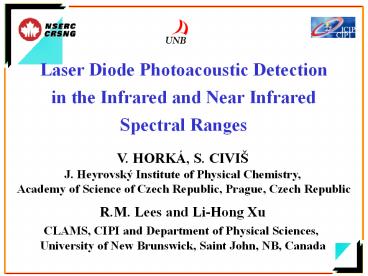Laser Diode Photoacoustic Detection - PowerPoint PPT Presentation
Title: Laser Diode Photoacoustic Detection
1
Laser Diode Photoacoustic Detection in the
Infrared and Near Infrared Spectral Ranges
- V. HORKÁ, S. CIVI
- J. Heyrovský Institute of Physical Chemistry,
- Academy of Science of Czech Republic, Prague,
Czech Republic - R.M. Lees and Li-Hong Xu
- CLAMS, CIPI and Department of Physical Sciences,
- University of New Brunswick, Saint John, NB,
Canada
2
Introduction
- High resolution optoacoustic detection with
diode lasers - Identical OA instrumentation (cell and
microphone) - Comparative study in four different spectral
regions
- Mid infrared 2100 cm-1 CO and OCS
fundamental band absorptions PbSe laser - Mid infrared 4200 and 4350 cm-1 CH4 and NH3
overtone absorptions GaAs laser - Near infrared 6500 cm-1 CO, CO2 and NH3
overtone and combination bands InP ECTDL
- Estimated detection limits for all of the gases
- Optimum gas pressures for maximum sensitivity.
3
Principle of optoacoustic detection
Absorption ? collisions ? relaxation ? kinetic
energy ? heat of the gas ? pressure change
Optoacoustic cell
Microphone
4
Laser characteristics
5
PbSe - 2100 cm-1
GaInAsSb/Ga AlAsSb/GaSb - 4300 cm-1
6
InP ECTDL 6500 cm-1 - UNB Newport 2010A
7
Methane and ammonia FT absorption spectra
8
CH4 FT, absorption and photoacoustic spectra
9
Analysis of the signal
Pressure regimes had the
absorption dominated by collisional broadening.
Lorentz curve was used for the line
shape
?0 abs. coeff. at line center w FWHM linewidth
Spectra were recorded in 2f mode and fitted by
Lorentz 2nd derivative
10
Signal intensity behaviour at 2100 cm-1
11
Signal intensity behaviour at 4200 cm-1
12
Signal intensity behaviour at 6500 cm-1
13
Trace-gas detection of NH3 and CO2 in car exhaust
Sample conditions a) Sample taken after 5 min
(car only in parking lot) 29 ppm of NH3
24.4 x 104 ppm of CO2 b) Sample taken after
7 min (car speed 50 km/hr) 9.6 ppm of NH3
24.4 x 104 ppm of CO2 c) Sample taken
after 25 min (car speed 100 km/hr) 9 ppm of
NH3 22.4 x 104 ppm of CO2
14
Variation of NH3 in exhaust with different
gasoline
Comparison of different gasoline a) Sample from
car exhaust with Regular gasoline Content
120 ppm of NH3 b) Sample from car exhaust with
Premium gasoline (better fuel) Content 10
ppm of NH3 c) Laboratory measured spectrum
Content 10 ppm of NH3
15
Results and Conclusions
- Best detection limit 1 ppm for NH3 at 4300
cm-1. - Optoacoustic detection at atmospheric pressure
is possible with the higher powered laser at
6500 cm-1.
PowerShow.com is a leading presentation sharing website. It has millions of presentations already uploaded and available with 1,000s more being uploaded by its users every day. Whatever your area of interest, here you’ll be able to find and view presentations you’ll love and possibly download. And, best of all, it is completely free and easy to use.
You might even have a presentation you’d like to share with others. If so, just upload it to PowerShow.com. We’ll convert it to an HTML5 slideshow that includes all the media types you’ve already added: audio, video, music, pictures, animations and transition effects. Then you can share it with your target audience as well as PowerShow.com’s millions of monthly visitors. And, again, it’s all free.
About the Developers
PowerShow.com is brought to you by CrystalGraphics, the award-winning developer and market-leading publisher of rich-media enhancement products for presentations. Our product offerings include millions of PowerPoint templates, diagrams, animated 3D characters and more.































